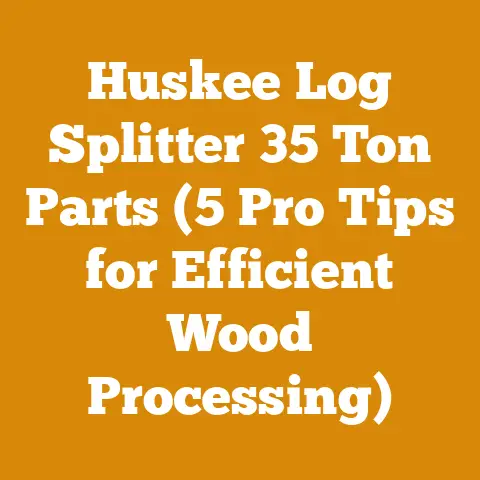BTU in Cord of Wood: Debunking Myths & Real Energy Insights (Expert Analysis)
Imagine a cold winter night. Snow is falling, the wind is howling, but inside, a cozy fire is crackling, casting a warm glow on the faces of your children. They are mesmerized by the dancing flames, listening to stories, and feeling safe and secure. That warmth, that feeling, comes from the energy stored within a seemingly simple cord of wood. As a technical content writer specializing in wood processing, logging, and firewood, my aim is to demystify the energy potential of firewood, specifically, the BTU (British Thermal Unit) content in a cord of wood. Let’s dive into the myths, the realities, and the expert insights needed to understand and maximize the heating power of your firewood.
BTU in a Cord of Wood: Debunking Myths & Real Energy Insights (Expert Analysis)
For years, I have worked with wood, from the forest to the fireplace. I’ve seen firsthand the misconceptions surrounding firewood and its heating capabilities. People often overestimate or underestimate the energy they’re getting, leading to inefficiency and frustration. My goal is to provide you with the knowledge to make informed decisions, ensuring you get the most heat for your buck – or, in this case, your cord.
What is a BTU and Why Does it Matter?
A British Thermal Unit (BTU) is the amount of energy required to raise the temperature of one pound of water by one degree Fahrenheit. In the context of firewood, BTU is the standard unit used to measure the amount of heat a particular type of wood can generate when burned. The higher the BTU rating, the more heat the wood will produce.
Knowing the BTU content of different wood species allows you to:
- Compare fuel sources: Determine which wood offers the best heating value.
- Estimate heating needs: Calculate how much wood you’ll need to heat your home or space.
- Make informed purchasing decisions: Choose wood that aligns with your budget and heating requirements.
The Cord: A Unit of Measure Steeped in History
Before we delve into BTU values, let’s clarify what a “cord” actually is. A standard cord of wood is defined as a tightly stacked pile measuring 4 feet high, 4 feet wide, and 8 feet long, totaling 128 cubic feet. However, this is where things get tricky. The actual amount of solid wood in a cord varies depending on how tightly the wood is stacked, the size and shape of the individual pieces, and the straightness of the logs. This is called the “void space”.
My Personal Experience: I remember a time when I bought a “cord” of wood from a local supplier. It looked like a cord, but when I stacked it myself, I realized there was significantly less wood than I expected. The logs were crooked and unevenly sized, creating a lot of empty space. This experience taught me the importance of visually inspecting the wood and understanding the stacking density.
Factors Affecting BTU Content
The BTU content of a cord of wood isn’t a fixed number. Several factors influence how much heat you’ll get:
- Wood Species: Different wood species have different densities and resin contents, directly impacting their BTU rating.
- Moisture Content: Wet wood requires energy to evaporate the water before it can burn efficiently. This significantly reduces the BTU output.
- Density: Denser woods generally have higher BTU ratings because they contain more combustible material per unit volume.
- Resin Content: Resinous woods, like pine, tend to ignite easily and burn hot, but they also burn faster.
Hardwood vs. Softwood: The Great BTU Debate
Generally, hardwoods (deciduous trees like oak, maple, and ash) have higher BTU ratings than softwoods (coniferous trees like pine, fir, and spruce). This is because hardwoods are denser. However, this isn’t always a hard-and-fast rule. Some dense softwoods can rival the BTU output of less dense hardwoods.
Here’s a general comparison:
| Wood Type | Approximate BTU per Cord (Million BTUs) | Burn Rate | Smoke Production |
|---|---|---|---|
| Oak | 24-30 | Slow | Low |
| Maple | 20-26 | Medium | Medium |
| Ash | 20-24 | Medium | Low |
| Birch | 20-24 | Medium | Medium |
| Beech | 22-27 | Slow | Low |
| Pine | 14-20 | Fast | High |
| Fir | 14-18 | Fast | Medium |
| Spruce | 12-16 | Fast | Medium |
Important Note: These are approximate values. Actual BTU content can vary depending on the specific species and growing conditions.
The Moisture Content Conundrum: The Biggest BTU Killer
Moisture content is the single most crucial factor affecting the BTU output of firewood. Freshly cut wood can have a moisture content of 50% or higher. Burning wet wood wastes energy, produces excessive smoke, and can even damage your chimney.
- Ideal Moisture Content: For optimal burning, firewood should have a moisture content of 20% or less.
- How to Measure Moisture Content: Use a wood moisture meter. These devices are relatively inexpensive and provide accurate readings.
- Seasoning is Key: “Seasoning” firewood means allowing it to dry properly. This typically involves splitting the wood, stacking it loosely in a well-ventilated area, and allowing it to air dry for at least six months, preferably a year or more.
Technical Specification: Wood Moisture Content
- Freshly Cut Wood: 50% or higher moisture content. Unsuitable for burning.
- Partially Seasoned Wood (3-6 months): 30-40% moisture content. Burns poorly, produces excessive smoke.
- Properly Seasoned Wood (6-12+ months): 15-20% moisture content. Burns efficiently, produces minimal smoke.
Drying Tolerances:
- Ideal Drying Conditions: Sunny, windy location with good air circulation.
- Minimum Drying Time: 6 months for softwoods, 12 months for hardwoods.
- Acceptable Moisture Content Variance: +/- 2% using a calibrated moisture meter.
Myth Busting: Common Firewood Misconceptions
- Myth #1: All wood burns the same. As we’ve discussed, different wood species have drastically different BTU ratings and burning characteristics.
- Myth #2: Bigger logs burn hotter. The size of the log doesn’t directly affect the BTU output. However, larger logs burn longer.
- Myth #3: Dead wood is always seasoned. Dead wood standing in the forest can still have high moisture content, especially if it’s been exposed to rain and snow.
- Myth #4: You can dry wood indoors. While you can store seasoned wood indoors to keep it dry, you can’t effectively dry green wood indoors. It needs proper air circulation.
- Myth #5: Any type of wood is safe to burn. Some treated woods, like pressure-treated lumber, contain chemicals that can release toxic fumes when burned. Never burn treated wood.
Tool Requirements: Chainsaws, Moisture Meters, and More
Working with firewood requires the right tools. Here are some essentials:
- Chainsaw: A reliable chainsaw is essential for cutting logs. Choose a model that’s appropriate for the size of the wood you’ll be cutting.
- Technical Specification: Chainsaw Calibration: Chainsaws should be calibrated regularly to ensure optimal performance and safety. This includes adjusting the carburetor, sharpening the chain, and checking the chain tension.
- Safety Codes: Always wear appropriate safety gear, including eye protection, hearing protection, gloves, and chaps, when operating a chainsaw.
- Wood Moisture Meter: As mentioned earlier, a moisture meter is crucial for determining the moisture content of your firewood.
- Splitting Axe or Maul: For splitting logs into smaller pieces.
- Wedges: Helpful for splitting particularly tough or knotty logs.
- Gloves: Protect your hands from splinters and abrasions.
- Safety Glasses: Essential for protecting your eyes from flying debris.
- Hearing Protection: Chainsaws are loud. Protect your hearing with earplugs or earmuffs.
- Measuring Tools: A tape measure or measuring wheel is helpful for determining the length of logs and the dimensions of your woodpile.
Safety Equipment Requirements
- Eye Protection: ANSI Z87.1-rated safety glasses or face shield.
- Hearing Protection: Noise Reduction Rating (NRR) of at least 25 dB.
- Gloves: Leather or heavy-duty work gloves.
- Chaps: Chainsaw chaps provide crucial protection for your legs.
- Steel-Toed Boots: Protect your feet from falling logs and sharp objects.
- Helmet: A hard hat is recommended, especially when working in the forest.
Wood Selection Criteria: Choosing the Right Species for Your Needs
When selecting firewood, consider the following factors:
- BTU Rating: Choose a species with a high BTU rating if you need a lot of heat.
- Burn Rate: Slower-burning woods provide longer-lasting heat.
- Smoke Production: Low-smoke woods are better for indoor use.
- Availability: Choose a species that’s readily available in your area.
- Cost: Compare the cost of different species to find the best value.
Practical Tip: Mix different types of wood to achieve a balance of heat output and burn time. For example, you might use a high-BTU hardwood like oak for sustained heat and a softwood like pine for quick ignition.
Tool Calibration Standards
- Chainsaw: Calibrate the carburetor according to the manufacturer’s instructions. Check and adjust chain tension regularly. Sharpen the chain as needed.
- Moisture Meter: Calibrate the moisture meter according to the manufacturer’s instructions. Replace batteries as needed.
- Splitting Axe/Maul: Keep the blade sharp. Inspect the handle for cracks or damage.
Case Study: Optimizing Firewood Drying in a Humid Climate
I once worked with a small firewood producer in a humid coastal region. They were struggling to dry their wood effectively, resulting in poor-quality firewood and dissatisfied customers.
The Challenge: High humidity levels slowed down the drying process, and frequent rainfall re-wetted the wood.
The Solution: We implemented several strategies:
- Improved Stacking: We switched from tightly packed piles to looser stacks with better air circulation.
- Strategic Location: We moved the woodpiles to a higher, sunnier location with better drainage.
- Covered Storage: We constructed a simple roof over the woodpiles to protect them from rain.
- Forced Air Drying: We experimented with using a large fan to circulate air through the woodpiles, significantly accelerating the drying process.
The Results: These changes dramatically improved the drying rate, resulting in drier, higher-quality firewood and happier customers. The moisture content dropped from an average of 40% to 18% within 6 months.
Technical Details:
- Original Stacking Method: Tightly packed rows, minimal air circulation.
- Improved Stacking Method: Loose stacks with 4-inch gaps between rows, promoting air circulation.
- Location Change: Moved from a shaded, low-lying area to a sunny, elevated location.
- Forced Air Drying: Used a 24-inch industrial fan for 4 hours per day.
- Moisture Content Reduction: From 40% to 18% in 6 months.
Log Dimensions and Cord Volumes: Getting the Math Right
Understanding log dimensions and cord volumes is crucial for accurate firewood measurement and pricing.
- Standard Cord: 4 feet high x 4 feet wide x 8 feet long = 128 cubic feet.
- Face Cord (or Rick): Typically 4 feet high x 8 feet long, but the depth varies. A face cord is not a standard unit of measure, so be sure to clarify the depth with the seller.
- Log Diameter: Measure the diameter of the log at its widest point. This will help you determine the appropriate splitting method and the size of the pieces you’ll need for your stove or fireplace.
- Log Length: Standard firewood lengths are typically 16 inches, but this can vary depending on the size of your stove or fireplace.
Practical Tip: Use a measuring wheel or tape measure to accurately determine the dimensions of your woodpile. This will help you avoid being shortchanged.
Material Specifications: Understanding Wood Properties
Understanding the properties of different wood species is essential for making informed decisions about firewood selection.
- Density: As mentioned earlier, density is a key factor in determining the BTU rating of wood. Denser woods generally have higher BTU ratings.
- Hardness: Hardness refers to the wood’s resistance to indentation and scratching. Harder woods tend to burn longer and produce less smoke.
- Resin Content: Resinous woods, like pine, ignite easily and burn hot, but they also burn faster and produce more smoke.
- Moisture Content: The most critical material specification. Aim for a moisture content of 20% or less.
- Species Identification: Learn to identify different wood species. This will help you assess their properties and make informed choices.
Industry Standards and Forestry Regulations
Firewood production and sales are often subject to industry standards and forestry regulations. These regulations may cover:
- Measurement Standards: Ensuring accurate measurement of firewood volumes.
- Pest Control: Preventing the spread of invasive pests and diseases.
- Sustainable Harvesting: Promoting responsible forest management practices.
- Permitting Requirements: Obtaining necessary permits for logging and firewood sales.
Important Note: Familiarize yourself with the local regulations in your area. This will help you avoid legal issues and ensure that you’re operating responsibly.
Firewood Storage: Keeping Your Wood Dry and Safe
Proper firewood storage is essential for maintaining its quality and preventing safety hazards.
- Location: Choose a well-drained location away from your house and other structures.
- Elevation: Elevate the woodpile off the ground to prevent moisture absorption and pest infestation.
- Covering: Cover the top of the woodpile to protect it from rain and snow.
- Air Circulation: Ensure good air circulation around the woodpile to promote drying.
- Pest Control: Inspect the woodpile regularly for signs of pests and take appropriate measures to control them.
Safety Considerations:
- Clearance: Maintain a clear area around the woodpile to prevent fire hazards.
- Stability: Stack the wood carefully to prevent it from collapsing.
- Accessibility: Ensure easy access to the woodpile for loading and unloading.
Practical Tips and Best Practices for Accurate Implementation
- Buy from Reputable Suppliers: Choose firewood suppliers with a good reputation for quality and honesty.
- Inspect Before You Buy: Visually inspect the wood for signs of rot, pests, or excessive moisture.
- Ask Questions: Don’t hesitate to ask the seller about the species, moisture content, and drying process.
- Use a Moisture Meter: Verify the moisture content of the wood before you buy it.
- Stack it Right: Stack the wood properly to promote drying and prevent collapse.
- Season it Well: Allow the wood to season for at least six months, preferably a year or more.
- Store it Safely: Store the wood in a well-drained, well-ventilated location.
- Burn it Wisely: Burn the wood efficiently to maximize heat output and minimize smoke production.
Conclusion: Mastering the Art of Firewood
Understanding the BTU content of a cord of wood is more than just a technical exercise. It’s about making informed decisions, maximizing efficiency, and ensuring that you get the most heat and enjoyment from your firewood. By understanding the factors that affect BTU content, choosing the right wood species, properly seasoning and storing your wood, and using the right tools and techniques, you can become a true firewood aficionado. And, most importantly, you can keep your family warm and cozy on those long winter nights, creating memories that will last a lifetime.
Remember, the warmth of a fire is not just about the wood itself, but also about the knowledge and care that goes into preparing and burning it. So, take the time to learn, experiment, and refine your skills. You’ll be rewarded with a more efficient, enjoyable, and fulfilling firewood experience.






